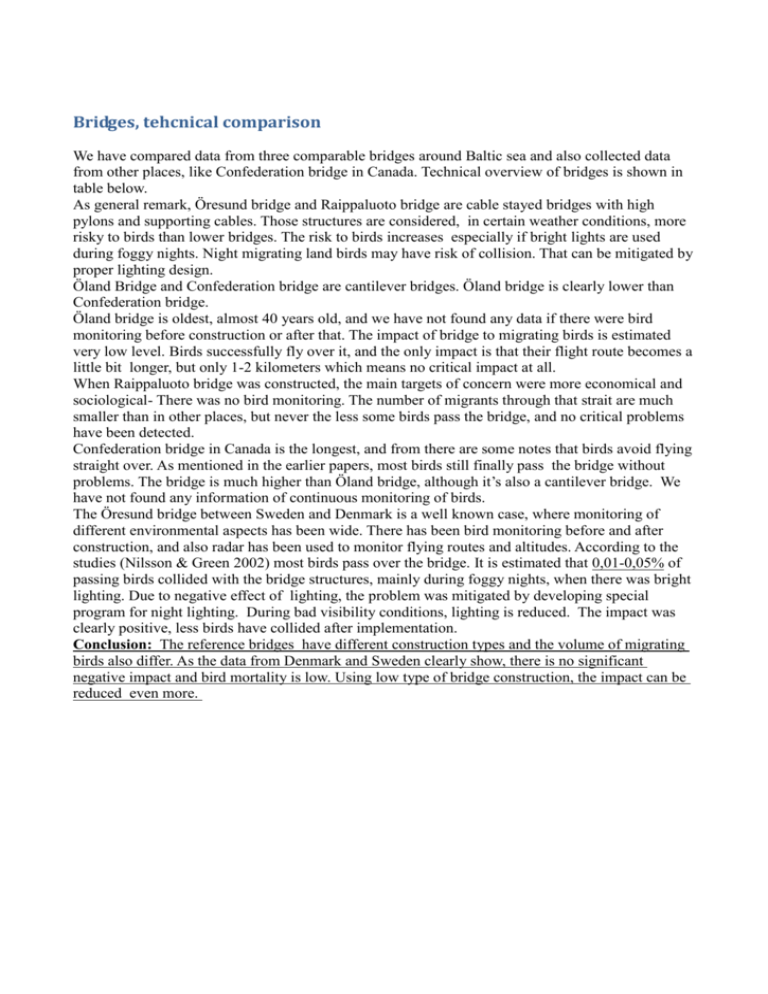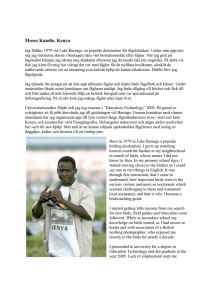Bridges, tehcnical comparison
advertisement

Bridges, tehcnical comparison We have compared data from three comparable bridges around Baltic sea and also collected data from other places, like Confederation bridge in Canada. Technical overview of bridges is shown in table below. As general remark, Öresund bridge and Raippaluoto bridge are cable stayed bridges with high pylons and supporting cables. Those structures are considered, in certain weather conditions, more risky to birds than lower bridges. The risk to birds increases especially if bright lights are used during foggy nights. Night migrating land birds may have risk of collision. That can be mitigated by proper lighting design. Öland Bridge and Confederation bridge are cantilever bridges. Öland bridge is clearly lower than Confederation bridge. Öland bridge is oldest, almost 40 years old, and we have not found any data if there were bird monitoring before construction or after that. The impact of bridge to migrating birds is estimated very low level. Birds successfully fly over it, and the only impact is that their flight route becomes a little bit longer, but only 1-2 kilometers which means no critical impact at all. When Raippaluoto bridge was constructed, the main targets of concern were more economical and sociological- There was no bird monitoring. The number of migrants through that strait are much smaller than in other places, but never the less some birds pass the bridge, and no critical problems have been detected. Confederation bridge in Canada is the longest, and from there are some notes that birds avoid flying straight over. As mentioned in the earlier papers, most birds still finally pass the bridge without problems. The bridge is much higher than Öland bridge, although it’s also a cantilever bridge. We have not found any information of continuous monitoring of birds. The Öresund bridge between Sweden and Denmark is a well known case, where monitoring of different environmental aspects has been wide. There has been bird monitoring before and after construction, and also radar has been used to monitor flying routes and altitudes. According to the studies (Nilsson & Green 2002) most birds pass over the bridge. It is estimated that 0,01-0,05% of passing birds collided with the bridge structures, mainly during foggy nights, when there was bright lighting. Due to negative effect of lighting, the problem was mitigated by developing special program for night lighting. During bad visibility conditions, lighting is reduced. The impact was clearly positive, less birds have collided after implementation. Conclusion: The reference bridges have different construction types and the volume of migrating birds also differ. As the data from Denmark and Sweden clearly show, there is no significant negative impact and bird mortality is low. Using low type of bridge construction, the impact can be reduced even more. Table: general data of reference bridges. Öresund bridge Öland Bridge (Kalmarsund) Type Cable stayed Cantilever bridge bridge Lenght 7845m 6072 m Highest point 204 m about 50 (no exact data found) Clearance below 57 m 36 m Opened July 1, 2000 30 September 1972 Raippaluoto bridge Cable stayed bridge 1045 m 82,5 m 26 m 27. august 1997 Confederation bridge, Canada Cantilever bridge 12900m less than 80 (no exact data found) 60 m May 31, 1997 Flying altitudes of birds Generally flying altitude of bids is not strictly species specific, but more or less group specific. For example, many raptors, geese and granes are flying relatively high during migration, and many smaller birds are flying lower. Also habitat influences flying altitude, many ducks and seabird fly low or just over water when they are crossing sea, but take more height when crossing continent. And they also fly higher during night than during day. Migration altitude can also be different than normal flying altitude near breeding or resting areas. Many night migrating long distance migrants fly even at several kilometers altitude when migrating, but normally they move at less than hundred meters altitude. The flying altitude of birds is probably more or less the same at all Baltic coasts. So we can assume, that those altitudes, which have been observed at Suur-Strait more or less reflect the normal flying altitudes of those species. So some species are flying low also in Sweden and Denmark. But despite that, the birds don’t fly against bridge (or other structures or cliffs etc). They can dodge them. As earlier said, exceptions are those situations, when for example the pylons of high bridges have heavy lightning and during foggy nights birds are “trapped by light” and continue flying around tower and finally hit structures. From Kalmarsund there are some notes about flying altitudes of birds. Pettersson has estimated in one of his studies that the average flying altitude of seabirds during day at south Kalmarsundwas 20 meters, and in his other study 109 meters (Pettersson 2005, 2009). During the night average altitude was 84 meters. Pettersson has aslo estimated that when passerine birds migrate over sea during night, their flying altitude is 200m-1200m. But, these are average numbers, there is a lot of flocks which fly much lower (see figure). Flying altitudes of birds migrating during daytime at Kalmarsund Flying altitudes of birds migrating during night time at Kalmarsund So the lowest altitudes of seabirds are at the same level as Kalmarsund bridge, or windmills. But there are only exceptional collisions. Sea birds either pass windmills left or right, of try to fly over, as they do when they reach bridge. Petterson (2005) has in one of his studies showed this behavior with common eider. Before wind mills, eiders fly at about 20 m altitude before windmills, and at 50 m when passing between windmills. Collisions against windmills were very rare, although they have moving rotors, so probably collisions against stable bridge structures of Kalmarsund bridge are even more rare. Litterature: Pettersson, J. 2005: Havsbaserade vindkraftverks inverkan på fågellivet I södra Kalmarsund. Lund universitet. Pettersson, J. : Flyttande små- och sjöfåglar - en förstudie med local radar I Kalmarsund. Naturvårdsvärket 2006. Number of birds migrating and staging near Öresund and Öland bridges It’s generally known that Öresund between Sweden and Denmark, and Kalmarsund between Swedish mainland and Öland island are important migration flyways for birds and also important wintering places for many water birds. It’s estimated, that during migration about 100 000 000 birds migrate through area between Öresund and Falsterbo cape at south-west Sweden (Nielsson & Geen 2002). During special migration study September-October 2001 at Öresund, over 100000 birds were count, representing 90 species. Dead birds were collected from the bridge and identified. Also, a radar study was carried out to study the migration routes of birds. As shown in next picture, many birds (mainly land birds) passed straight across to Denmark, but many birds also flew over bridge. General flight directions (yellow arrows) in the area around the Öresund bridge according to the radar study. Note: bridge is ‘Bro’ Tracks of 16 bird flocks seen from Lernacken and followed by the radar. Yellow arrows: Barnacle Geese. Blue arrows: Greylag Geese, Red arrows: Wood Pigeon. The number of dead birds was relatively low. All found dead birds are shown in next table. Note, that no water birds were found, most of birds are night migrating passerines. Nielsson and Green estimated that 0,01-0,05% of passing birds collide with the bridge structures. Number of dead birds found on the Öresund bridge, September – December 2001. Stenfalk Falco clumbarius Rörhöna Galinula ochropus Morkulla Scolopax rusticola Gråtrut Larus argentatus Havstrut Larus marinus Stadsduva Columbia ”domestica” Jorduggla Asio flammeus Hornuggla Asio otus St hackspett Dendrocopus major Trädlärka Lullula arborea Sånglärka Alauda arvensis Ängpiplärka Anthus pratensis Gärdsmyg Troglodytes troglodytes Rödhake Erithacus rubecula Koltrast Turdus merula Björktrast Turdus pilaris Rödvingetrast Turdus iliacus Taltrast Turdus philomelos Trädgårdssångare Sylvia borin Svarthätta Sylva atricapilla Lövsångare Phylloscopus trochilus Gransångare Phylloscopus collybita Kungsfågel Regulus regulus Blåmes Parus caeruleus Sept 1 – 15 Okt 16 -31 Okt 1 1 1 1 1 1 2 2 1 1 2 1 5 12 1 4 5 1 2 10 63 52 Nov Dec 2 1 1 4 1 1 1 12 1 4 21 1 1 1 10 9 1 1 17 4 Total 1 1 1 4 1 1 4 1 3 1 17 10 3 125 1 1 4 37 1 2 2 2 28 13 Skata Pica pica Kråka Corvus corone Bofink Fringilla coelebs Bergfink Fringilla montifringilla Grönsiska Carduelis spinus Gråsiska Carduelis flammea Gulsparv Emberiza citrniella Dvärgsparv Emberiza pusilla Sävsparv Emberiza schoeniclus Småfågel NN Passeres spp. TOTAL 6 1 1 1 3 2 1 1 23 1 1 5 127 1 1 1 4 1 141 5 1 From Öland bridge no monitoring data is found, but a lot of waterbirds migrate throught strait. We know that huge number of eiders pass Kalmarsund, Sweden. Almost 1 000 000 eiders pass Öland Island during migration, and many of them use Kalmarsund and must pass the bridge. For example on 5.4.1992 130000 birds were recorded to have passed Beijerhamn, just a few kilometres south of the bridge (Lindell 2002: Sveriges fåglar). 1 1 10 3 1 1 2 1 5 6 295 How far of other bridges are the nearest staging areas? It has been said, that Suur-Strait differs from Öresund and Kalmarsund because many birds are also resting so near bridge. I measured distances from nearest Natura-areas to the middle of Öresund bridge and Kalmarsund bridge, results are in table. Öresund bridge is practically very near Natura area, because the west end of bridge is at Saltholmen. Nearest Natura 2000 areas, birds directive: Natura code Öresund bridge DK002X110 DK002X111 Kalmarsund bridge SE0430002 SE0430173 SE0330054 SE0330109 SE0330083 SE0410053 Name Saltholm og omliggende hav Vestamager og havet syd for Falsterbo-Foteviken Lommaområdet Beijershamn och Svansholmarna Eckelsudde Ottenby Kristianopels skärgård Distance (to middle of bridge about 3 km about 13 km about 13 km about 14 km about 7 km about 27 km about 50 km about 50 km Many of these Natura areas are important breeding sites, but also important wintering areas for many seabirds and wader. Also, a lot of birds rest out site these areas near bridges, as can be seen from next picture. Picture: wintering waterbirds near Öland bridge How bird and seal studies were used at Natura-assessment? Both bird and seal study from Suur-Strait was used as bases of Natura-assessment. The data from bird study show the number of birds, migration routes and altitudes clearly. Seal study showed the migration route and time of ringed seals. The only difference is, that in Natura –assessment the conclusion about impacts significance is not the same as in special studies. Comparison to published literature and experiences from other bridges don’t show as critical impacts as said in Suur-Strait bird study. Also the published data about other seal species and ringed seals in Saimaa does not show that bridges cause significant impacts to seals, if mitigation measures and best practices are used during construction. The experiences from Öresund bridge and Öland bridge can be used as reference to Suur-Strait. No significant negative impacts to population levels have been found there.
